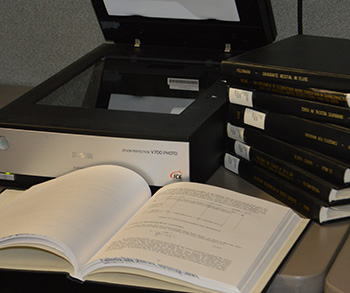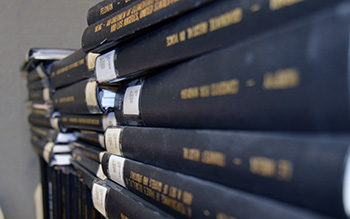eNews Edition: Spring 2017
Contributed by Library Web Services Coordinator Elizabeth Altman

Scanning station and bound theses used as part of the Electronic Thesis and Dissertation Digitization Project.
In the most recent election cycle many of us became skeptical of what seems to be an overload of web-based information. CSUN students pay for the benefit of having quality, peer-reviewed research and information at their disposal in training for their postgraduate lives. To expand those resources, the Library in recent years has initiated and participated in projects to bring graduate student research theses online, from the present day all the way back to the university’s founding.
Plans to move theses and dissertations online started taking shape in 2008, under the auspices of former Provost Harry Hellenbrand, former Library Dean Susan Curzon, and the late Associate Vice President of Graduate Studies, Mack Johnson. At that time, students submitted multiple copies of their printed graduate thesis to the Research and Graduate Studies office, who in turn shipped them to the bindery and distributed the bound volumes to the academic departments and the Library. The goal of the Electronic Thesis and Dissertation (ETD) application, a project authored by graduate student Kate Vigna as part of her Master’s degree in Computer Science, was to move the entire process online, from committee selection to approval of the finished product, and of course, eliminate the bindery. Instead of shipping theses to the bindery, Research and Graduate Studies was to send them electronically to the CSU ScholarWorks Open Access Repository. The ETD application was piloted in Fall 2011 and became central to the thesis process starting Spring 2012.
This advance opened up CSUN graduate student work to the world, but the Oviatt Library still had over 14,000 master’s theses dating back to 1957 sitting on the shelves or stored in the Automated Storage and Retrieval System (ASRS). “Having student theses online and replacing the paper process streamlines pretty much everything. That got me wondering, what should we do with the rest of them?” remembers Andrew Weiss, Digital Services Librarian. Starting summer 2013, Weiss submitted a series of Campus Quality Fee (CQF) proposals that funded the digitization and archiving of printed theses. “We started with anything submitted between 1957 and 1989 that was arguably under ‘public domain’ because of then-current copyright law,” Weiss explains. The next three phases brought in all theses with an audio or video component, then the 2000-2011 series, and finally those submitted between 1990 and 1999.
Ninety percent of the CQF funding has gone to hire students to scan pages and optimize the PDF files. Weiss worked with former Systems and Emerging Technologies Librarian Lauren Magnuson to automate the process of adding metadata that would make the student theses easily searchable. “At this point we can process one calendar year’s worth of thesis submissions in a month.” To date there are over 15,500 theses in the ScholarWorks collections. All submissions have a written component archived in PDF format, but may also be accompanied by supporting files such as videos, audio recordings, maps, and images.

Bound theses and dissertations waiting to be scanned as part of the ETD project.
Both students and faculty benefit from the open availability of graduate student work. Francine Oschin, who received her Master’s degree in Mass Communication in 1985, is “happy that the master’s theses were digitized and accessible to people and researchers around the world – my grandson even read my thesis.” It is also easier for current students to find a thesis related to their area of study. Additionally, the digitized theses are a step closer to being accessible for mobility-restricted and blind users. Students don’t have to browse the shelves, and it is easier for them to find a thesis related to their area of study. The Library retains one bound copy in Special Collections, but removing the print copies from the stacks has freed up space for additional study areas. “Hardly anybody accessed the print versions, especially when they were in the ASRS. Users are finding things through Google, and our catalog isn’t indexed by Google. Now we have subject cataloging and full-text search. It’s completely transformative – we’ve created a better version of the original,” says Weiss. Another benefit of the online theses and dissertations collections is transparency – students can see which faculty have advised on which projects. This showcases faculty mentoring and helps students choose an advisor. “Transparency always improves quality – the more you’re transparent of what is in the collection, the better the collection will be, the more students will have access to good models of what to do in the future,” Weiss observes.
When asked what future holds for publishing student work, Weiss suggests the library might now turn to capturing culminating experiences. In the near future the ETD collections will be cataloged in the unified library management system, a 23-campus catalog that goes live in June, making CSUN graduate student work more visible across the CSU system. Ultimately he’d like to see ScholarWorks become a member of the Networked Digital Library of Theses and Dissertations (NDLTD), which is building an international catalog.
Congratulations, you found the Freud!  The password for Fall 2017 is Digitization. The first 50 readers who find the Freud and bring the password to the Freudian Sip in the Oviatt Library will receive a free cookie with their purchase.
The password for Fall 2017 is Digitization. The first 50 readers who find the Freud and bring the password to the Freudian Sip in the Oviatt Library will receive a free cookie with their purchase.


